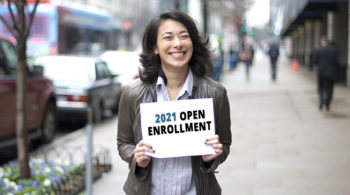Before the pandemic struck, Himali Patel and her brother owned five small retail businesses.
Now they’re down to one — a dry cleaning establishment. They have seen a disheartening drop in their income as COVID-19 ravaged the economy.
Patel, an Atlantan who has multiple medical conditions, has been getting her health insurance through the Georgia exchange. The federal Affordable Care Act (ACA) created these exchanges in the various states, so people who don’t have coverage through an employer or government agency can buy health insurance at a reasonable price.

She had been paying $400 a month. With her drop in income, that’s now at $60.
But with the COVID relief bill, just signed into law by President Biden, her premium should drop to zero.
“That will be nice,’’ says Patel, 31. “Nearly all of my savings have been depleted so it’ll be nice to be able to save some money right now.’’
The American Rescue Plan has injected the first major financial boost into the ACA in the 11 years since the health law was passed.
Many people already get subsidies or discounts — based on their income — so they can afford the coverage they get on their state’s exchange.
The newly enacted relief legislation provides, for the first time, subsidy help to those earning more than the current cap of 400 percent of the federal poverty level – about $51,000 for an individual and $104,800 for a family of four in 2021. Currently, they get no such discounts, and pay the full premium for coverage.
The new law also guarantees that people with incomes up to 150 percent of poverty won’t have to pay any premium for a benchmark exchange plan. And others currently getting subsidies will see them increase, lowering their monthly costs.
These price breaks will be retroactive to Jan. 1, so people who already have insurance exchange plans will get money back.
The relief bill also helps the unemployed. If someone receives unemployment benefits during 2021, that person’s income will be treated as no higher than 133 percent of the poverty level for exchange coverage. This means they can receive maximum subsidies, including no-premium coverage.

With these changes in federal law, enrollment in health exchanges will undoubtedly swell. “It will have an important effect on expanding coverage,’’ said Bill Custer, a health insurance expert at Georgia State University.
Insurance agents say they’re trying to figure out the effect of the provisions.
The subsidy boost could be especially helpful for people in southwest Georgia, an area that has some of the highest premiums in the nation, said Laura Colbert of the consumer advocacy group Georgians for a Healthy Future.
“Every consumer who shops for coverage will get a better deal than they were able to get even a few weeks ago,’’ she said. “Consumers with higher incomes who previously received no financial help will see their premiums drop so that they are no longer paying more than 8.5 percent of their income.”
Enrollment window is open
Ordinarily, the large share of sign-ups in the exchanges occurs late in the year during the standard open enrollment, in which people buy their coverage for the subsequent year. But these are not ordinary times.
Biden has ordered a special, temporary sign-up period for the exchanges, and it’s going on now through May 15.

This special enrollment window was created to help people dealing with the economic fallout of the COVID-19 pandemic. But many potential customers may be unaware of it.
Custer said that if the feds want to get the word out about the enhanced subsidies and enrollment opening, there needs to be a marketing push before the May 15 deadline.
Already, more than 16,000 Georgians have taken advantage of the extended sign-up window. That’s the third-highest total of any state — behind heavily populated Florida and Texas — among the 36 states that let the federal government run their exchanges. (The other states run their own exchanges.)
More than 500,000 Georgians signed up last fall during the regular enrollment period.
Weighing price and benefits
The lower premiums may not entice everyone who has an individual insurance policy.
Christopher Halstead of Plains buys a short-term policy for himself and his son. Such insurance plans have far fewer benefits than exchange policies but attract buyers because of the low cost.
A contract security worker, Halstead, 35, said last week that he doesn’t believe the recalculated premiums from the exchange will be less than the $250 a month he’s paying now for the short-term plan.
Halstead used to have an exchange policy, so he’s well aware they offer more benefits.

Of the improved premium situation in the exchange, he said, “I would check to see if it was a better deal.’’
(Here’s a calculator to assess where a person’s new premium would be.)
The improved premium subsidies will last just two years.
They could be extended beyond that period, and if they are, “insurers will increase participation in marketplace [exchange] plans,’’ Custer said.
As exchange coverage becomes affordable for more people, he said, some smaller employers eventually could stop providing health insurance to their workers, instead giving them financial help to buy it on the exchanges.
Among other health care features, the American Rescue Plan will also make COBRA coverage much less expensive.
The law will subsidize 100 percent of the cost of premiums for COBRA coverage for up to 6 months for workers who are laid off or see their hours reduced. The COBRA subsidy is available only to individuals whose termination or loss of work hours was involuntary.
Those who qualify for the COBRA subsidy could pay less than current employees do, Custer said. “They may prefer that plan to an exchange plan.’’
(Here’s a GHN article about the incentives for Medicaid expansion in the COVID relief bill.)

